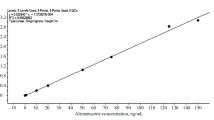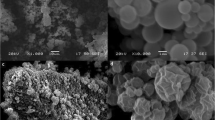Abstract
CHF1194 is an inclusion complex of β-cyclodextrin with the nonsteroidal anti-inflammatory drug piroxicam. In man, β-cyclodextrin acts as a carrier of piroxicam. As the inclusion complex of piroxicam-β-cyclodextrin is wettable and more water soluble, the absorption rate of the drug is increased whilst its other pharmacokinetic characteristics remain unchanged.
The aim of the present study in 12 healthy subjects was to compare the oral bioavailability of 20 mg piroxicam in a CHF1194 tablet and a plain piroxicam capsule after a single dose and after two weeks of once daily administration, and also to assess the plasma levels and urinary excretion of β-cyclodextrin after CHF1194 administration. The two treatments were administered in cross-over fashion, separated by a wash-out period of three weeks. Piroxicam, 5′-hydroxypiroxicam and β-cyclodextrin were monitored in plasma and urine for 120 h after the first and last doses.
Clinical tolerance was excellent and no adverse event occurred during either phase of the study. The extent of absorption of piroxicam from the CHF1194 tablet after the single dose was equivalent to that after the plain piroxicam capsule, within confidence limits of less than 80–125%. After repeated dosing, CHF1194 yielded the same steady-state systemic concentrations of piroxicam and 5′-hydroxypiroxicam as the reference capsule, and similar excretion pattern of the metabolite. After both single and multiple dosing, piroxicam was absorbed more rapidly after CHF1194, an expected consequence of the complexation of piroxicam with β-cyclodextrin. This may be of therapeutic interest as it might accelerate the onset of pain relief.
The pharmacokinetics of piroxicam was linear after the doses used here, suggesting that long term treatment with CHF1194 should not require any change in dosing regimen. Even after 14 days of repeated administration of CHF1194, β-cyclodextrin could not be detected in plasma or urine, suggesting that in man the unchanged oligosaccharide was absorbed to a very small extent.
Similar content being viewed by others
References
Brogden RN, Heel RC, Speight TM, Avery GS (1981) Piroxicam: a review of its pharmacological properties and therapeutic efficacy. Drugs 22: 165–187
Hobbs DC (1983) Pharmacokinetics of piroxicam in man. Eur J Rheumatol Inflamm 6: 46–55
Schiantarelli P, Acerbi D, Bovis G (1981) Some pharmacokinetic properties and bioavailability by oral and rectal route of piroxicam in rodents and in man. Arzneimittelforschung/Drug Res 31: 92–97
Richardson CJ, Blocka KL, Ross SG, Verbeeck RK (1985) Effects of age and sex on piroxicam disposition. Clin Pharmacol Ther 37: 13–18
Ishizaki T, Nomura T, Abe T (1979) Pharmacokinetics of piroxicam, a new nonsteroidal anti-inflammatory agent, under fasting and postprandial states in man. J Pharmacokinet Biopharm 7: 369–381
Szejtli J (1990) Cyclodextrins: properties and applications. Drug Invest 2 [Suppl 4]: 11–21
Acerbi D (1990) Pharmacokinetic profile of piroxicam β-cyclodextrin. Drug Invest 2 [Suppl 4]: 43–49
Fronza G, Mele A, Redenti E, Ventura P (1992) Proton Nuclear Magnetic Resonance spectroscopy studies of the inclusion complex of piroxicam with β-cyclodextrin. J Pharm Sci 81: 1162–1165
Acerbi D, Lebacq E, Rondelli I, Stockis A, Ventura P (1990) Rapid oral absorption profile of piroxicam from its β-cyclodextrin complex. Drug Invest 2 [Suppl 4]: 50–55
Acerbi D, Bonati C, Boscarino G, Bufalino L, Cesari F, D'Ambrosio E, Mansanti P, Scali G (1988) Pharmacokinetic study on piroxicam at the steady-state in elderly subjects and younger adults after administration of piroxicam beta-cyclodextrin. Int J Clin Pharm Res 8: 175–180
Santucci L, Fiorucci S, Patoia L, Farroni F, Sicilia A, Chiucchiu S, Bufalino L, Morelli A (1990) Gastric tolerance of piroxicam β-cyclodextrin compared with placebo and with other NSAIDs: an endoscopic and functional study for evaluation of transmucosal potential difference. Drug Invest 2 [Suppl 4]: 56–60
Otero Espinar FJ, Anguiano Igea S, Blanco Mendez J, Vila Jato JL (1991) Reduction in the ulcerogenicity of naproxen by complexation with β-cyclodextrin. Int J Pharm 70: 35–41
Szejtli J (1987) The metabolism, toxicity and biological effects of cyclodextrins In: Duchene D (ed) Cyclodextrins and their industrial uses. Editions de Santé, Paris, pp 175–210
Cadel S, Bongrani S (1990) Toxicological profile of piroxicam β-cyclodextrin. Drug Invest 2 [Suppl 4]: 37–41
Richardson CJ, Ross SG, Verbeeck RG (1986) HPLC analysis of piroxicam and its major metabolite 5′-hydroxypiroxicam in human plasma and urine. J Chromatogr 382: 382–388
Frijlink HW, Visser J, Drenth BHF (1987) Determination of cyclodextrins in biological fluids by high-performance liquid chromatography with negative colorimetric detection using post-column complexation with phenolphtalein. J Chromatogr 415: 325–333
Gibaldi M, Perrier D (1982) Pharmacokinetics, 2nd ed. Dekker, New York
Fleiss JL (1986) The design and analysis of clinical experiments Wiley, New York
Hauschke D, Steinijans VW, Diletti E (1990) A distribution-free procedure for statistical analysis of bioequivalence studies. Int J Clin Pharmacol Ther Toxicol 28: 72–78
Steinijans VW, Hauschke D (1990) Update on the statistical analysis of bioequivalence studies. Int J Clin Pharmacol Ther Toxicol 28: 105–110
Richardson CJ, Blocka KL, Ross SG, Verbeeck RK (1987) Piroxicam and 5′-hydroxypiroxicam kinetics following multiple dose administration of piroxicam. Eur J Clin Pharmacol 32: 89–91
Nuotio P, Makisara P (1978) Pharmacokinetic and clinical study of piroxicam. Roy Soc Med Int Congr Symp Ser 1: 25–30
Acerbi D, Ventura P (1991) β-cyclodextrin-piroxicam: pharmacokinetic profile. J Drug Develop, 4 [Suppl 1]: 17–19
Hollander D, Ricketts D, Boyd CAR (1988) Importance of ‘probe’ molecular geometry determining intestinal permeability. Can J Gastroenterol, 2 [Suppl A]: 35A-38A
Author information
Authors and Affiliations
Rights and permissions
About this article
Cite this article
Deroubaix, X., Stockis, A., Allemon, A.M. et al. Oral bioavailability of CHF1194, an inclusion complex of piroxicam and β-cyclodextrin, in healthy subjects under single dose and steady-state conditions. Eur J Clin Pharmacol 47, 531–536 (1995). https://doi.org/10.1007/BF00193707
Received:
Accepted:
Issue Date:
DOI: https://doi.org/10.1007/BF00193707




